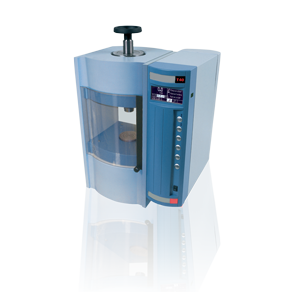How Does a Hydraulic Press Work?
A hydraulic press is used to consolidate sample materials into a flattened disc or pellet of consistent flatness and density. This is ideal for x-ray fluorescence (XRF) analysis which provides both quantitative and qualitative measurements of a sample’s elemental composition based on its subvisible excitation wavelengths. Matrix effects from surface variations and localized heterogeneities can alter a sample’s emission spectra, impacting net spectral measurements and impairing the accuracy of XRF spectrometry results.
Compacting samples using a hydraulic press enables analysts to perform spectral measurements on an ideal surface that is as close to a homogeneous representation of the bulk material as possible.
In this blog post, we will explore the working principle of a hydraulic press and explore some of the pressing technologies available from XRF Scientific in more detail.
 Outlining Hydraulic Presses
Outlining Hydraulic Presses
A hydraulic press operates on Pascal’s law of pressure and confined fluids, which states that the pressure of fluids in a closed system will transmit from one surface area to another undiminished. This principle underlines many hydraulics applications and is routinely used to press materials for laboratory sample preparation.
Typically, a hydraulic press comprises an oil reservoir, a ram or a piston, and a pump. The pump is used to pressurize the fluid, building the force that will act upon the piston. This allows a comparatively small force acting on a narrow channel from the reservoir to force the fluid against the larger surface area of the piston, generating a magnified unit of force. Using this methodology, it is possible to produce multi-ton compressive forces for XRF sample preparation.
Working Principles of XRF Scientific Hydraulic Presses
At XRF Scientific, we provide four hydraulic press product ranges for sample preparation applications. Our manual hydraulic press operates on the simple principle outlined above, with a manually-operated lever and an accurate pressure gauge enabling a maximum 25-ton capacity, with low tonnage conversion kits available for lower pressure applications.
We also offer a motorized hydraulic press to eliminate the time-consuming process of manually generating pressure in the oil reservoir. It features a power-assisted pump that is controlled using the integrated manometer, with a maximum capacity of up to 25-tons. This capability is taken a step further with our power hydraulic press range, which uses microprocessor controls to pre-determine the pressure values across a maximum range of 3 – 25-tons in 1-ton increments.
The automatic hydraulic press is our highest pressure capability press with a maximum 40-ton load capacity and intuitive microprocessor control. Users can pre-determine up to 6 operation cycles with up to 10 individual segments, for tight-control of sample pressing for higher throughput applications.
If you would like any more information about our hydraulic press product range, please do not hesitate to contact us.









